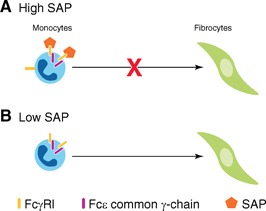Figure 2.

SAP inhibits fibrocyte formation. (A) When SAP is present in the tissue, as is the case in early inflammation, SAP binds to FcγRI to inhibit fibrocyte differentiation. Deletion of the FcγRI or the FcRγ significantly reduces the inhibitory effect of SAP. (B) At late stages of inflammation, when SAP levels are low, monocytes differentiate into fibroblast‐like cells called fibrocytes. Fibrocytes then secrete ECM components, such as collagen and extracellular‐modifying enzymes, to restore the architecture of the damaged tissue.
